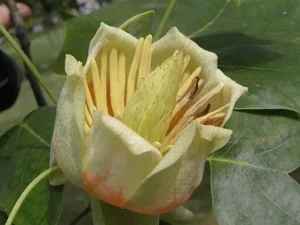Chapter 16. Major Initiatives of the Pennsylvania Academy of Science
Nomimation of the State Flower for Pennsylvania

Flower of tuliptree — Rob Hille, Public domain, via Wikimedia Commons
In 1929, the Pennsylvania Academy of Science, nominated the tuliptree (Liriodendron tulipifera) to be the state flower for Pennsylvania. Ultimately, the mountain laurel (Kalmia latifolia) was chosen to be the state flower and the eastern hemlock (Tsuga canadensis), the state tree. It is thought that the wife of Gifford Pinchot, who was Governor at the time, liked the flowers of mountain laurel, and she had more influence than others had. The hemlock was chosen because it had more timber value in Pennsylvania.
Establishment of Minimum Requirements for Pennsylvania Science Teachers
In 1936, the Committee of Science Certification Requirements was established by Dr. John C. Johnson of West Chester University, who was President of PAS at the time. During a 23 year effort the requirements were eventually passed by the legislature and enacted in the fall of 1963.
Conservation of Special Concern Areas and the Natural Areas Program in Pennsylvania
This was a project of the Conservation Committee and others and led to the protection of numerous natural areas and the Natural Heritage Program present in Pennsylvania today.
Go to Chapter 17: Hall of Pennsylvania Academy of Science Presidents